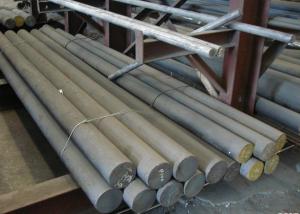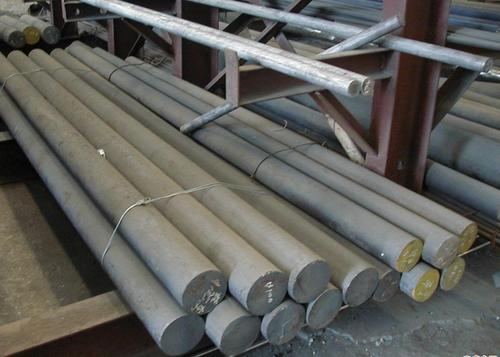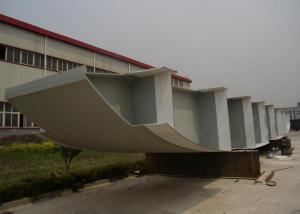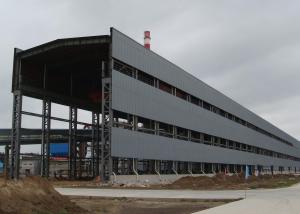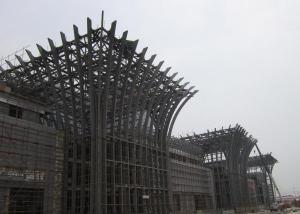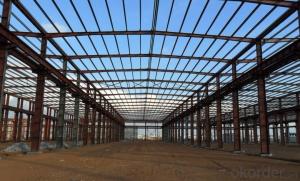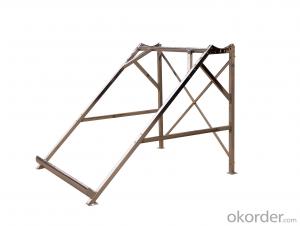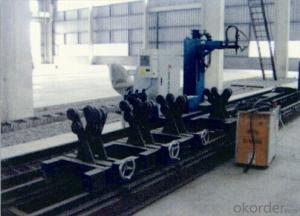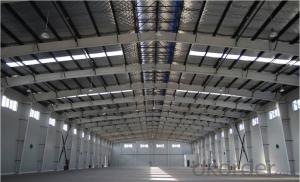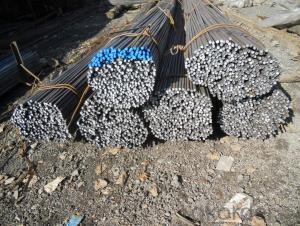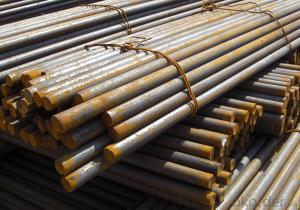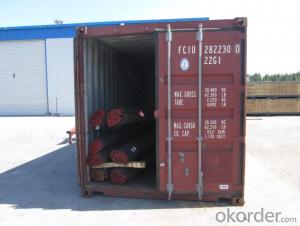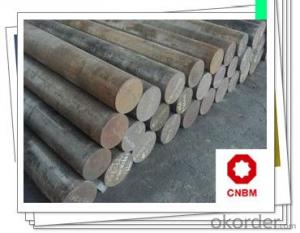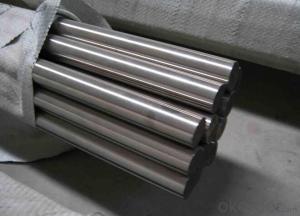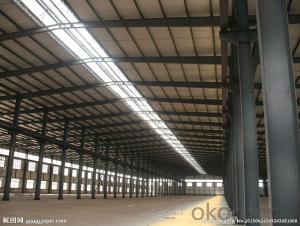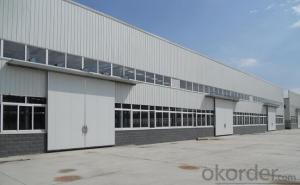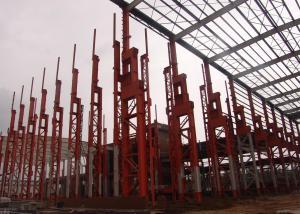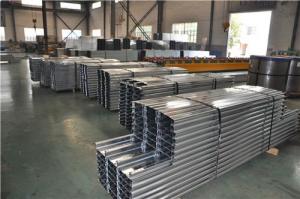Steel Round Bar Products
- Loading Port:
- Tianjin
- Payment Terms:
- TT or LC
- Min Order Qty:
- 25 Tons m.t.
- Supply Capability:
- 50000 tons per month m.t./month
OKorder Service Pledge
OKorder Financial Service
You Might Also Like
Specifications of Steel Round Bar Products
1. Grade: Q235, A36, SS400, S235JR
2. Feature: Unbreakable, grinding resistant and high impact value
3. Diameter: 8mm-150mm
4. Performance: Mainly for civil construction
5. Characteristics: Even hardness, no deformation, no breaking, no mal-roundness
6. Technique: Hot rolled
7. Mass: Mass (kg/m) = Diameter (mm) × Diameter (mm) × 0.00617
Usage and Applications of Steel Round Bar Products
1. Steel round bar products is used in construction and a large number of architectural and engineering structures. And it can be used in production of handrail, windows, machinery, telecom and curtain wall.
2. It can be used in the fields like metal mines, cement plants, water coal slurry, power stations and chemical industry.
3. Besides, we can supply some especial material steel round bar that can be used for main shaft of steamer, hummer shank, with big section and supper force.
4. Recommended watchcase factory, screw factory and other cold stamping products industry use.
Packaging & Delivery of Steel Round Bar Products
Packaging Detail: All goods are packed in bundle with steel strips and shipped by break bulk vessel or container (depend on target market and different ports)
Delivery Detail: 45 days
Trade terms: FOB, CFR, CIF
MOQ: 25 tons per specification; we can negotiate the quantity if the specification is normal or we have stock of one specification.
Weight: The price invoicing on theoretical weight basis or actual weight basis depends on customer’s request.
Shipment: The shipment of bulk break or container is depends on customer’s request and the situation of the port of destination.
Documents given: Full set of original clean on board bill of lading; Original signed commercial invoice; Original packing list; Policy of insurance; Certificate of origin and what the target market needs.
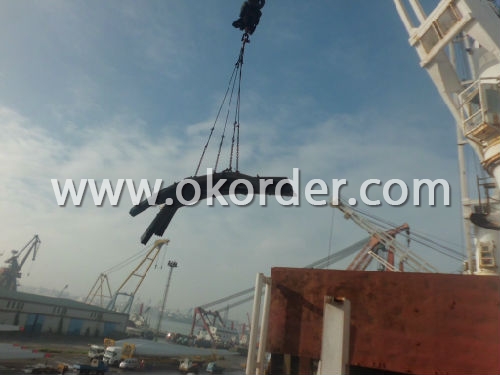
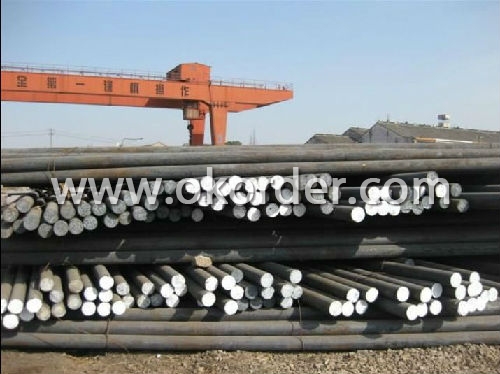
Production Flow of Steel Round Bar Products
Material prepare (billet) — heat up — rough rolling — precision rolling — cooling — packing — storage and transportation
Characteristics of Steel Round Bar Products
1. The steel in which the main interstitial alloying constituent is carbon in the range of 0.12–2.0%.
2. As the carbon percentage content rises, steel has the ability to become harder and stronger through heat treating; however it becomes less ductile.
3. Regardless of the heat treatment, higher carbon content reduces weld ability. In carbon steels, the higher carbon content lowers the melting point.
4. Quality should be in conformity with the specification of the manufacturer. Quantity and packing conditions should be in conformity with the term in the contract.
- Q: How are steel structures designed to be resistant to blast and explosion loads?
- Various strategies and design considerations can be utilized in order to enhance the blast and explosion resistance of steel structures. To begin with, the careful selection of materials and their properties plays a crucial role. Steel, known for its remarkable strength and ductility, is an ideal choice for blast-resistant structures. The incorporation of high-strength steel grades can augment the load-bearing capacity of the structure and bolster its resistance against blast forces. Moreover, the structural design itself significantly contributes to enhancing resistance. Blast-resistant design principles revolve around engineering structures that can endure the immense pressure and dynamic loads produced by explosions. This can be achieved by utilizing sturdy structural connections, such as welding or high-strength bolts, to ensure the integrity and stability of the structure. Additionally, the configuration and layout of the steel structure can greatly influence its blast resistance. By integrating blast-resistant features, such as reinforced walls, blast-resistant windows, and blast-resistant doors, the structure can better withstand the impact of an explosion. The design should also take into consideration the potential for progressive collapse, guaranteeing that the structure remains intact and prevents the propagation of failure in the event of a blast. Furthermore, the utilization of protective systems can further enhance the blast resistance of steel structures. Applying blast-resistant coatings or cladding to the structure can absorb and dissipate the energy generated by an explosion. These protective systems act as sacrificial layers, mitigating the effects of the blast on the underlying steel structure. Lastly, computer simulations and advanced analysis techniques, such as finite element analysis, can be employed to predict and evaluate the behavior of the structure under blast loads. These tools enable engineers to optimize the design and improve the blast resistance of steel structures by identifying potential weaknesses and areas of concern. In conclusion, by considering a combination of material selection, structural design considerations, incorporation of blast-resistant features, use of protective systems, and advanced analysis techniques, steel structures can be designed to withstand blast and explosion loads. This comprehensive approach ensures the safety and integrity of steel structures in the event of an explosion.
- Q: How do steel structures provide resistance against soil settlement?
- Soil settlement can be effectively prevented by steel structures due to their inherent strength, rigidity, and load-bearing capacity. When properly designed and implemented, steel structures have the capability to distribute and transfer significant loads imposed by the structure to the underlying soil, thus minimizing the potential for settlement. A crucial aspect to consider is the utilization of deep foundations, such as driven piles or drilled shafts, which penetrate deep into the ground to reach more stable soil layers. These foundations are responsible for transferring the structural loads to the competent soil layers, thereby reducing the risk of settlement. Furthermore, steel structures can be designed to span over weak or compressible soils, thus minimizing direct contact between the structure and problematic soil. This approach prevents excessive pressure on the soil, which could lead to settlement, by spanning over the weak areas. In addition, steel structures can be constructed with flexible connections that allow for some degree of movement and deformation. This flexibility helps to accommodate any minor settlements that may occur and prevents the structure from experiencing significant stress concentrations, which could result in further settlement. Moreover, steel structures can be designed to evenly distribute the loads across the foundation, thus minimizing differential settlement. By ensuring a uniform load distribution, the structure avoids excessive stress concentration on localized areas, reducing the risk of settlement. In conclusion, steel structures effectively resist soil settlement by utilizing deep foundations, spanning over weak soils, incorporating flexible connections, and distributing loads evenly. These design strategies help to mitigate the effects of settlement, ensuring the stability and long-term performance of the steel structure.
- Q: What does a product frame refer to in a steel structure workshop?
- A frame should refer to a section. This section can completely express a plane beam column component, mainly on the map to express the shape of the frame beam column, reinforcement, reinforcement layout and overlap anchorage, and so on.
- Q: How are steel structures used in hospitals and healthcare facilities?
- Steel structures are commonly used in hospitals and healthcare facilities due to their durability, strength, and ability to withstand extreme conditions. They provide a safe and reliable framework for constructing various areas such as operating rooms, patient wards, laboratories, and storage facilities. Steel structures also allow for flexible design possibilities, easy expansion or modification, and are resistant to fire, pests, and natural disasters. Additionally, steel's hygienic properties make it suitable for environments that require strict cleanliness standards, ensuring the safety and well-being of patients and medical staff.
- Q: What are the advantages of using steel structures in the chemical industry?
- The advantages of using steel structures in the chemical industry include their high strength-to-weight ratio, durability, and resistance to corrosion and fire. Steel structures can withstand heavy loads and provide excellent structural integrity, making them suitable for supporting large equipment and storage tanks. Additionally, steel structures can be easily modified or expanded, allowing for future changes in the layout or requirements of the chemical plant. Overall, steel structures offer long-term reliability and cost-effectiveness in the chemical industry.
- Q: What is the performance and function of steel structure engineering?
- Steel structure engineering is mainly made of steel, with large span, steel structure, workshop frame, steel structure workshop, light overall, saving foundation, little material, low cost and short construction period. Safe and reliable, beautiful appearance, stable structure and other advantages. Steel structure workshop is widely used in large span industrial buildings, warehouses, cold storage, high-rise buildings, office buildings, multi-storey parking lots and houses and other construction industry.
- Q: What are the different types of steel used in steel structures?
- There are several different types of steel used in steel structures, including carbon steel, high-strength low-alloy (HSLA) steel, stainless steel, and weathering steel. Each type has its own unique properties and is chosen based on factors such as strength, corrosion resistance, and desired aesthetic appearance.
- Q: How do steel structures perform in terms of resistance to impact and blast loads?
- Steel structures generally perform well in terms of resistance to impact and blast loads. Due to their high strength and ductility, steel is known for its ability to absorb and distribute impact and blast forces effectively. Steel structures can withstand significant impact loads without collapsing or causing major damage, making them a preferred choice for buildings and infrastructure in high-risk areas. Additionally, steel can be reinforced or designed to specifically enhance its blast resistance, further enhancing its performance in such scenarios.
- Q: What are the advantages of using prefabricated steel structures?
- There are several advantages to using prefabricated steel structures: 1. Speed and Efficiency: Prefabricated steel structures are manufactured off-site in a controlled environment, which allows for faster construction times and fewer delays due to weather or other external factors. The streamlined production process and standardized components ensure that the construction process is efficient and time-saving. 2. Cost-Effective: Prefabricated steel structures are generally more cost-effective compared to traditional construction methods. The use of standardized components and bulk purchasing of materials reduces the overall cost of the project. Additionally, the faster construction time leads to reduced labor costs and allows for earlier project completion, resulting in lower financing and overhead expenses. 3. Durability and Strength: Steel is a highly durable and strong material, making it an ideal choice for constructing structures that need to withstand harsh weather conditions or heavy loads. Prefabricated steel structures are designed to be resistant to earthquakes, hurricanes, and other natural disasters. Moreover, steel is resistant to pests such as termites and is non-combustible, ensuring the safety and longevity of the structure. 4. Customization and Flexibility: Prefabricated steel structures offer a high degree of customization and flexibility in terms of design and layout. They can be engineered to meet specific requirements, whether it's a small residential building or a large industrial facility. The modular nature of prefabricated steel components allows for easy expansion or modification in the future, making it a versatile option for any construction project. 5. Environmental Sustainability: Steel is a recyclable material, and using prefabricated steel structures promotes sustainability. The construction process generates less waste compared to traditional construction methods. Additionally, steel structures are energy-efficient, as they can be insulated easily, resulting in lower energy consumption and reduced carbon footprint. 6. Quality Control: Prefabricated steel structures are manufactured in a controlled environment, ensuring high-quality standards are met. The strict quality control measures in the factory setting, such as precision cutting and welding, result in consistently well-built structures. This quality assurance leads to a higher level of reliability and reduces the risk of structural issues in the long run. Overall, the advantages of using prefabricated steel structures include speed and efficiency, cost-effectiveness, durability and strength, customization and flexibility, environmental sustainability, and quality control. These benefits make prefabricated steel structures a popular choice for a wide range of construction projects.
- Q: How are steel structures designed for loading docks?
- Steel structures for loading docks are designed with careful consideration of the specific loading requirements. This involves analyzing the expected loads, such as the weight of trucks, forklifts, and cargo, and designing the structure to withstand these loads without deformation or failure. Factors such as the size and spacing of beams, columns, and connections, as well as the selection of appropriate materials and reinforcement, are all taken into account to ensure the safety and durability of the loading dock structure.
1. Manufacturer Overview
| Location | Hebei, China |
| Year Established | 1995 |
| Annual Output Value | Above US$ 15 Million |
| Main Markets | Middle east; Southeast Asia; Africa; East Aisa |
| Company Certifications |
2. Manufacturer Certificates
| a) Certification Name | |
| Range | |
| Reference | |
| Validity Period |
3. Manufacturer Capability
| a) Trade Capacity | |
| Nearest Port | Tianjin |
| Export Percentage | 20%-35% |
| No.of Employees in Trade Department | 11-20 People |
| Language Spoken: | English; Chinese |
| b) Factory Information | |
| Factory Size: | Above 6,500 square meters |
| No. of Production Lines | 1 |
| Contract Manufacturing | OEM Service Offered |
| Product Price Range | Average |
Send your message to us
Steel Round Bar Products
- Loading Port:
- Tianjin
- Payment Terms:
- TT or LC
- Min Order Qty:
- 25 Tons m.t.
- Supply Capability:
- 50000 tons per month m.t./month
OKorder Service Pledge
OKorder Financial Service
Similar products
Hot products
Hot Searches
Related keywords
